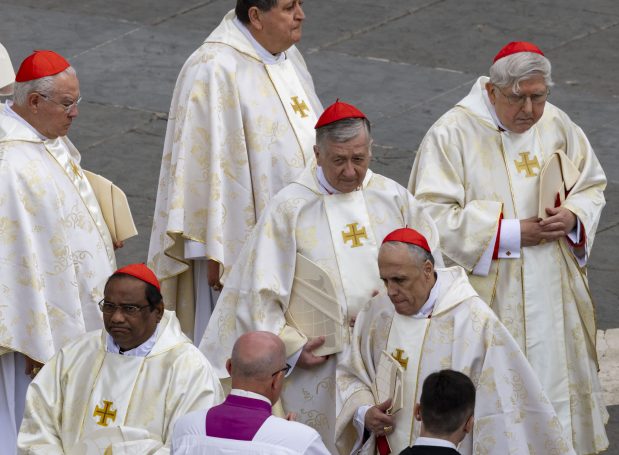A year ago, the city of Chicago was in the beginning stages of housing thousands of migrants in tents on a former industrial site contaminated with toxic metals.
That effort carried on for another two months, funded in part by the state, before Gov. JB Pritzker killed the plan at the eleventh hour when it became clear how foolhardy it was. Preparation of the site in the Southwest Side neighborhood of Brighton Park and tent construction already were well underway when Pritzker intervened.
The Brighton Park fiasco was one of the first signs for Chicagoans of the ineptitude of Mayor Brandon Johnson’s administration, then in its early months. It also was one of the early indications that the relationship between Chicago’s mayor and the governor would be frosty.
A year later, the mayor and the governor are engaged in another face-off, this time over funding of Chicago’s public schools. With his current effort to fire Chicago Public Schools CEO Pedro Martinez in the middle of a fraught contract negotiation with the Chicago Teachers Union, Johnson is behaving every bit as recklessly and foolishly as he did in confronting the migrant crisis.
Except in this case the stakes go to the heart of Chicago’s future, given Johnson’s desire to add more high-cost debt to a school district that already is the nation’s single largest junk bond issuer in order to pressure Pritzker and lawmakers in Springfield to bankroll CTU’s agenda.
The governor would be well advised to learn from what happened a year ago and call Johnson and CTU President Stacy Davis Gates on their bluff right here and now — before they’ve replaced Martinez with a more union-friendly schools boss and obtained Chicago Board of Education approval for a new high-cost loan of $300 million or more. Pritzker should not wait for a full-blown crisis to act.
Already, as we’ve written, business and philanthropic heavyweights are in the beginning stages of organizing to stop Johnson’s fiscal sabotage. Aldermanic opposition is mounting as well. But all of this civic pressure likely won’t be sufficient, given the obvious determination of Johnson to put his mayoral thumb on the collective-bargaining scale and give CTU, his former employer and current political benefactor, a victory yielding hundreds if not thousands of new union jobs in a district at historically low enrollment levels.
The only person in Illinois with the power to return Chicago to a course of stability and rationality is the governor. So far, though, Pritzker has issued mild reproaches to Johnson while allowing that he’d like to find more money for K-12 schools throughout the state. That’s not yet strong enough.
Everyone would like more funding to be available for all sorts of needs, but the trouble, of course, is that the tax burden in Illinois and in Chicago already is too heavy. And there are many pressing areas for Springfield to address, such as the $700 million funding cliff facing the Chicago area’s transit agencies. With a third of Chicago’s public schools serving half or fewer of the students they were built to educate, no rational policymaker would conclude it wise to raise taxes by hundreds of millions, not just to preserve an already bloated system but to add to the bloat.
The strategy of Johnson and Davis Gates is clear. It’s to put Springfield in a trap in which state government is “forced” to cough up the cash to pay for CTU’s absurd demands because the alternative — state receivership? bankruptcy? — is too politically painful.
Pritzker surely is aware of this. But to date, he has soft-pedaled his message. Just Wednesday, he told reporters, “Borrowing to pay for operating expenses in a business or in government, etc., is not a great idea unless you know how to pay for that because it’s going to come due.”
Well, yes. It’s not a great idea; it’s a terrible idea. But Johnson and Davis Gates think they do know how to pay for it: Make Pritzker responsible for the problem.
At the same time he was gently chiding Johnson and Davis Gates for their fiscal recklessness, Pritzker acknowledged Illinois wasn’t adequately funding K-12 schools yet. This is a decades-old problem. But there’s a statute on the books, signed in 2017 by Republican Bruce Rauner, under which the state is gradually increasing aid to schools, to the tune of about $350 million annually statewide. Under the law’s evidence-based school funding model, which CTU supported, Illinois is providing nearly $1.8 billion to CPS this year, a $26 million increase over the previous year. Assuming the state continues on the same path next year, CPS will see a similar increase.
But Chicago now is facing a more immediate crisis — and, yes, that’s the word.
The governor needs at this moment to speak out forcefully and publicly. He should say that CPS should plan next year on the set allocation per the fundamental changes enacted in 2017. No more, no less.
Johnson and Davis Gates need to be put on notice now — before Johnson’s appointed school board fulfills his wishes — that no bailout is coming. And that they risk losing control to the state if they can’t address CPS’ funding shortfalls on their own.
Submit a letter, of no more than 400 words, to the editor here or email letters@chicagotribune.com.



